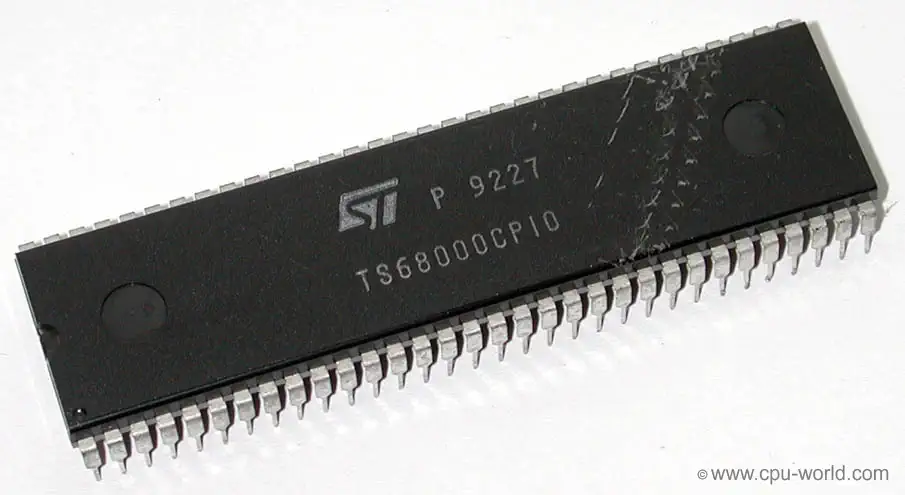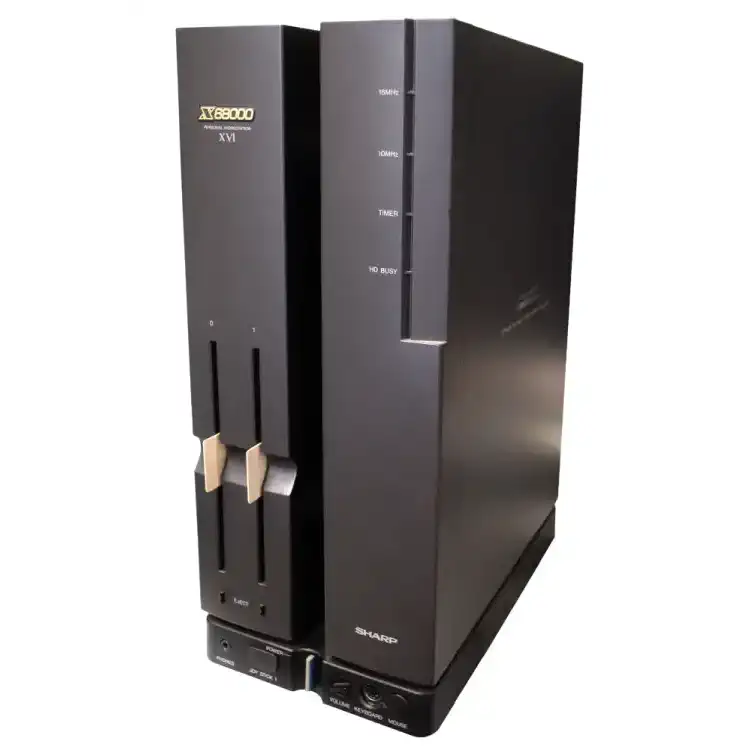Introduction
The sharp X68000 is a home computer created by the Sharp Corporation in 1987. The computer is based on the Motorola 68000 architecture and was capable of arcade style graphics in high resolution and color.
The machine came standard with 1MByte of RAM, and another 1056Kbyte of Video RAM. The Video Ram was split between text, graphics and sprite memory:
- 512 KByte for Graphics
- 512 KByte for Text
- 32 KByte for Sprites
The X68000 had a 65536 color palette and could display all of those simultaneously in a resolution of 512x512. The machine could display 128 sprites simultaneously with a maximum of 32 sprites per scanline. Sprites are 16x16 in size, and can use 16 colors out of 16 palettes of 64K colors. A total of 256 sprites could be stored in the VRAM.
For advanced graphics, the x68000 had multiple layers of screen, in so called bitmap planes:
- 1 layer of 512x512 in 64K Colors (or 1024x1024 in 64 from 64k Colors)
- 2 layers of 512x512 in 256 Colors out of 64K Colors
- 4 layers of 512x512 in 16 colors out of 64K colors
Technical specifications:
- Main CPU:
- X68000 model: Hitachi HD68HC000 @10MHz
- XVI model: Motorola 68000 @16MHz
- X68030 model: Motorola MC68EC030 @25MHz
- Co-Processor: Oki MSM80C51 MCU
- Graphics Processing Unit:
- X68000 model:
- CYNTHIA Jr Sprite Controller
- VINAS CRT Controller
- VSOP Video Controler
- RESERVE Video Data Selector
- ACE to X68030 models:
- CYNTHIA Sprite Controller
- VICON CRT Controller
- VIPS Video Controller
- CATHY Video Data Selector
- X68000 model:
- Sound Chips:
- Yamaha YM2151: 8 FM Synthesis channels
- Yamaha YM3012: Floating Point DAC with 2-channel stereo output
- Oki MSM6258: 4-bit ADPCM Mono channel @15.6kHz sampling rate
There were various models in the X68000 line that differed in configuration: faster CPU, more memory, hard drive option, more I/O slots and upgraded Software Bundles. The main model groups are the X68000 and the X68030, with the latter using the Motorola MC68EC030 Processor at 25MHz, giving the machine a significantly faster performance.
Motorola 68000 CPU Family
The Motorola 68000 is a 16/32-bit microprocessor that was first released in 1979. It was widely used in computers and other electronic devices during the 1980s and early 1990s. The 68000 was known for its advanced architecture, which included a 32-bit internal bus and a 24-bit address bus, allowing it to access up to 16 megabytes of memory. This made it more powerful than many other processors of its time, such as the Intel 8086 and Zilog Z80. It was also designed to be highly modular and expandable, with a large number of on-chip and off-chip peripherals.
Some of the most famous and successful computers that used the 68000 was the Commodore Amiga and the Atari ST, both of which were popular in the home and personal computer markets. Additionally, it was also used in workstations, such as the Sun 3 and Apollo DN3000, and in a wide variety of embedded systems and industrial control systems. The 68000 was also used in the Macintosh, the first model of the Macintosh was powered by a Motorola 68000 CPU. The processor was eventually succeeded by the 68020 and 68030, which offered improved performance and additional features.
The 68000 has a 32-bit instruction set, with 32-bit registers and a 16-bit internal data bus. The address bus is 24-bit and does not use memory segmentation, making it easier to address memory. There are three ALU's (Arithmetic Logic Unit), two for calculating addresses, and one for data, and the chip has a 16-bit external address bus.
The 68000 architecture was expanded with 32-bit ALUs, and caches. Here is a list with some 680x0 versions and their major improvements:
- 68010 - Virtual memory support
- 68020 - 32-bit ALU & Instruction Cache
- 68030 - On-Chip MMU, 2x 256 byte cache
- 68040 - 2x 4K Cache, 6 stage pipeline, FPU
- 68LC040 - No Floating Point Unit (FPU)
- 68060 - 2x 8K Cache, 10 stage pipelinet

Source: WikiPedia - Motorola 6800
Source: WikiPedia - 68000 Series
VRAM: 1MB
32kB Sprite RAM, 16kB SRAM Sound Chip FM - Yamaha YM2151DAC - Yamaha YM3012ADPCM - Oki MSM6258 (4-bit) Sound 8 Channel FM, DAC, 4 bit ADPCM Display Chip none Display 64k Colors max
512x512 in 64k colors
1024x1024 in 16 out of 64k colors
Hardware scrolling, super-impose, sprite-flipping, dual tile-map layers Best Color 64k colors Best Graphics 1024x1024 in 16 out of 64k colors Sprites 128 16x16, 16 color sprites. 16/scanline System OS Human68K OS (ver 1.0 to 3.02), SX-Window Storage Dual 5.25" Floppy disk drives, optional 20-80MByte Hard Drive


